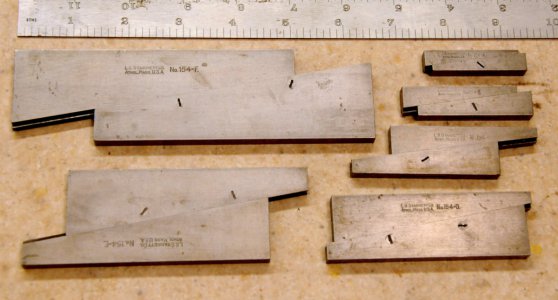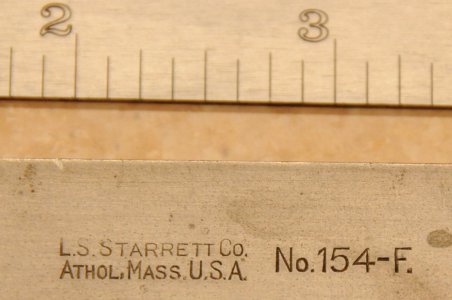- Joined
- Jun 7, 2013
- Messages
- 10,104
I agree with the prior posters; main use is measuring slots; secondary, used as an adjustable gage block. There are two sizes beyond the familiar Starrett set of five. I use them fairly often, but never as a vise parallel. If you want vise parallels, peruse Brown & Sharpe or Starrett on E Bay.
Also very a very useful acessory is hold downs, used to hold workpieces in a mill or shaper vise; they are a strip of hard steel, tapered in it's width and slightly angled on the thick side; one is laid on each side of the workpiece against the vice jaws; when the vise is tightened, the angled back causes them to exert pressure downwards, holding the work tightly against the parallels under the part; they are especially nice under thin work that is difficult to seat tightly in a vise. Starrett sells them in 4 and 6" lengths; for longer work, they can be used in tandem, that is two on each side of the part. I have seen (and have)a set that is 12" long, for use on the shaper, likely home made.
As to the gage block use, another time saving gage is a step gage; I have a pair of them made with steps in 1/16" increments from 1/8" to 1", the first from 1/8" to 9/16", the second from 5/8" to 1". They are especially handy to use in conjunction with the carriage stop in the lathe. My set was made by tool & die apprentices at the Mare Island Naval Shipyard during WW-2; they are made of tool steel and are hardened and ground to close limits. When I sold my business, I left that set for the new owner, and made a set for myself for my retirement shop at home.
Also very a very useful acessory is hold downs, used to hold workpieces in a mill or shaper vise; they are a strip of hard steel, tapered in it's width and slightly angled on the thick side; one is laid on each side of the workpiece against the vice jaws; when the vise is tightened, the angled back causes them to exert pressure downwards, holding the work tightly against the parallels under the part; they are especially nice under thin work that is difficult to seat tightly in a vise. Starrett sells them in 4 and 6" lengths; for longer work, they can be used in tandem, that is two on each side of the part. I have seen (and have)a set that is 12" long, for use on the shaper, likely home made.
As to the gage block use, another time saving gage is a step gage; I have a pair of them made with steps in 1/16" increments from 1/8" to 1", the first from 1/8" to 9/16", the second from 5/8" to 1". They are especially handy to use in conjunction with the carriage stop in the lathe. My set was made by tool & die apprentices at the Mare Island Naval Shipyard during WW-2; they are made of tool steel and are hardened and ground to close limits. When I sold my business, I left that set for the new owner, and made a set for myself for my retirement shop at home.



